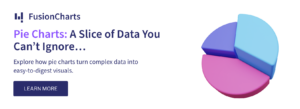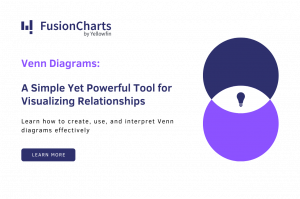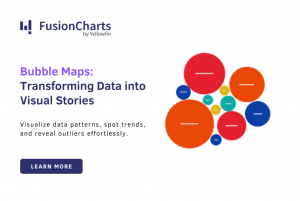This is the third post in our series “Principles of Data Visualization“#PoDV
We began this series by discussing the importance of data visualization in business before moving on to the two goals in data visualization: explanation and exploration. Now that we understand how data visualization works in business scenarios, let’s look at the mechanics of processing visual data. In this post, we’ll explain the role of memory in perceiving visual information and apply that knowledge as we work with visualizations. We recommend FusionCharts for data visualization if you’re looking for a Data Visualization Tool.Table of Contents
How Vision Works
The eyes and the brain are partners in the visual process. In traditional BI terms, the ETL occurs with the eyes and the information processing with the brain. The optic nerve that connects the eyes to the brain is an information highway. Studies show that the eyes transmit information to the brain at ethernet speeds. Due to this close relationship between the two, mental health experts have observed that poor eyesight also affects memory. Also, mental health issues affect a person’s vision. When discussing data visualization, we often consider what looks good and often neglect the importance of memory in the visual process. However, memory is equally, if not more important, than eyesight.Eyesight and Memory Working in Parallel
If you’re familiar with big data terminology, you would have come across the term “massively parallel processing” (MPP). MPP is most commonly seen in MapReduce technology that powers Hadoop. It breaks data down into small units and processes each of the units in parallel. We have always used a similar process to process information with our vision as well. When we look at a visual, our eyes and brains work in parallel to take in new information and break it into small chunks. Then, the eyes and the brain process these chunks in parallel to find meaning. Let’s look at an example to understand this better. Let’s say we walk into a supermarket to buy oranges. Our eyes first scan the layout of the supermarket. At the same time, our brain processes the various sections of the layout and instructs the eyes to zone in on the fruits section. It does this by sending signals about how fruits look from memory. The eyes then break the entire scanned area into parts and scan each section to spot the fruits section. The exact process repeats till we zero in on the oranges in the fruits section. This process of visualizing information is performed by the eyes and memory working in parallel.
Let’s say we walk into a supermarket to buy oranges. Our eyes first scan the layout of the supermarket. At the same time, our brain processes the various sections of the layout and instructs the eyes to zone in on the fruits section. It does this by sending signals about how fruits look from memory. The eyes then break the entire scanned area into parts and scan each section to spot the fruits section. The exact process repeats till we zero in on the oranges in the fruits section. This process of visualizing information is performed by the eyes and memory working in parallel.
The Role of Memory in Vision
While that’s an overview of how we process visual information, let’s discuss the vital role of memory in our vision. Two types of memory come into play when we process visual information.
- Long-term memory
- Working memory
Long-Term Memory
This type of memory arises from past interactions and experiences. It is stored in our brains to be accessed whenever needed. This type of memory makes us expect the units to be marked on the X and Y axes of a chart or the date range selector at the top of a dashboard.
It would help if you considered long-term memory when designing the layout of a dashboard or visualization. There should be a good reason to go contrary to long-term memory when deciding its basic structure. While a detailed discussion on this topic is out of the scope of this series, for an overview of concepts related to long-term memory, see our white paper ‘Designed to succeed—How design is playing a strategic role in today’s software products.’ While long-term memory is vital in data visualization, the more critical memory when processing visual information is our working memory.
Working Memory
When we look at a line chart or notice a number in a dashboard, we use our working memory to store just the information we need at the moment. This type of memory breaks the entire visual into small chunks of information, in a process appropriately called ‘chunking.’ Surprisingly, for all the complexity of our brain, our working memory can hold only about three chunks of information at any given time. When perceiving a complex visual, we’re constantly replacing the three available slots in our working memory. When designing a visual or a dashboard, one of our goals is to remove distractions and pack as much helpful information as possible into each chunk. While we want to avoid information overload, allowing the designer to direct the viewer’s attention naturally. Let’s look at how to apply this learning when designing a chart.
Edward Tufte, a data visualization expert, termed the distractions in a chart as ‘chartjunk.’ He defines chartjunk as the ‘elements in charts that are not necessary to comprehend the information represented on the graph.’ In his book ‘The Visual Display of Quantitative Information,’ he gives this example about reducing chartjunk for better visual expression:
By reducing chartjunk as much as possible, we can best use a viewer’s working memory. We can also build more effective dashboards.



